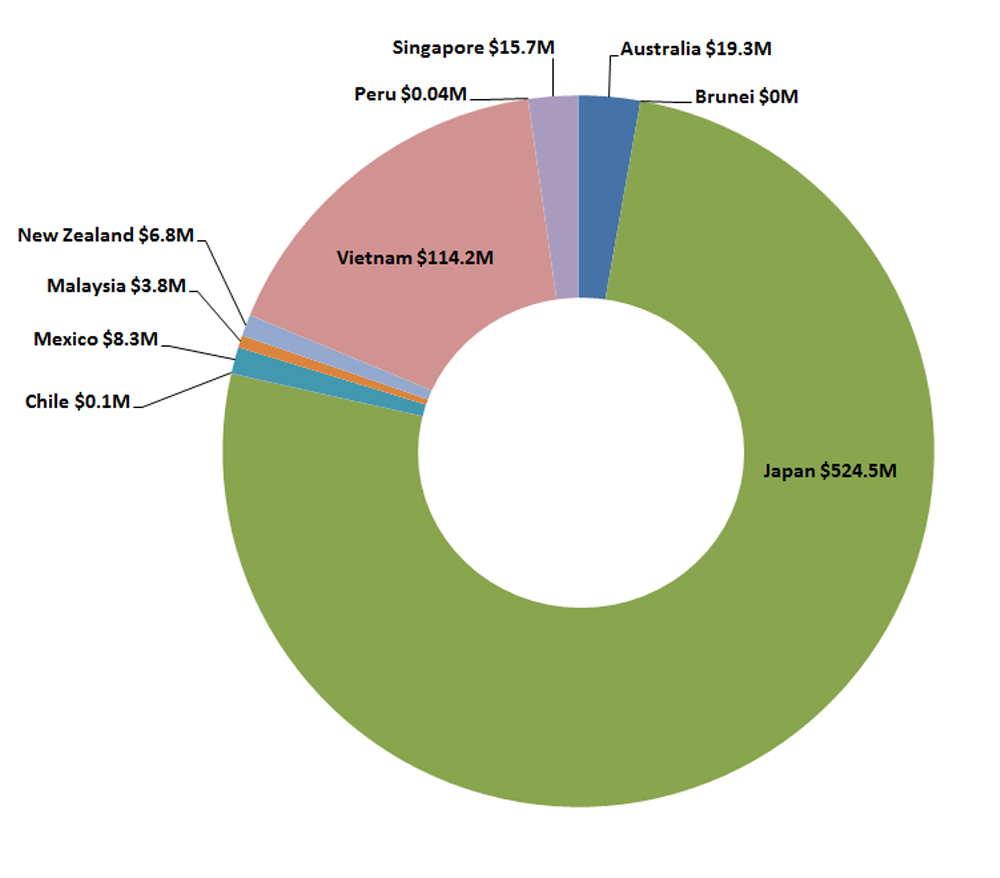What does the CPTPP mean for the fish and seafood sector?
Summary / Overview
Upon entry into force, the CPTPP Agreement will eliminate most tariffs on Canadian fish and seafood exports, creating new opportunities in key markets such as Japan, Malaysia and Vietnam. The remaining fish and seafood tariffs will be phased out over periods of up to 15 years.
Tariff Elimination
Canadian exports of fish and seafood products currently face tariffs in a number of CPTPP markets, including Japan and Malaysia (up to 15%), Vietnam (up to 34%) and New Zealand (up to 5%). These tariffs hinder Canada’s competitiveness by making Canadian fish and seafood products more expensive.
These products include the following:
- snow crab
- herring roe
- lobster (including processed)
- shrimp
- salmon
- scallops
- halibut
- mussels
- fish fillets
- sea urchins
- bluefin tuna
- oysters
When the CPTPP Agreement enters into force in each relevant CPTPP market, the vast majority of Canadian fish and seafood products will benefit from duty-free access, with tariffs on remaining products to be phased out over periods of up to 15 years.
How the CPTPP benefits exporters
The CPTPP will create new export opportunities through the elimination of tariffs as well as rules on technical barriers to trade and sanitary and phytosanitary measures. This will allow Canadian businesses to capitalize on growing demand in the region for fish and seafood products.
Japan in particular has traditionally been known for its high per-capita consumption of fish and seafood. The country is a key market for premium seafood products from Canada such as snow crab, shrimp, lobster, herring roe, sea urchin, salmon and halibut.
Canada’s fish and seafood exports will gain an advantage over competitors from countries that do not have a free trade agreement or have less ambitious access to CPTPP markets.
When the CPTPP enters into force, about 66% of Japan’s tariff lines, nearly 83% of Vietnam’s tariff lines and 100% of Malaysia’s tariff lines on fish and seafood will be duty-free, with the remainder to be eliminated within 15 years.
By generating opportunities for Canadian fish and seafood exports, the CPTPP will bring benefits to Canadian businesses and workers.
Trade Snapshot
Fish and seafood are among Canada’s largest exports of food products.
- In 2016, Canada exported a record $6.6 billion in fish and seafood products.
- In 2015, the fish and seafood industry provided approximately 72,000 jobs to Canadians in fish harvesting, aquaculture production and seafood processing.
- The fish and seafood industry is an economic mainstay of many communities in rural and coastal Canada.
- In 2016, Canada was the eighth-largest exporter of fish and seafood products.
Key Facts and Figure
- From 2014 to 2016, the annual value of Canada’s fish and seafood exports to CPTPP countries averaged $693 million.
Annual Canadian Fish and Seafood Exports to CPTPP Countries (2014-16 average, $CAD)

Text version
| Partner Countries | 2014-16 average ($CAD) |
|---|---|
| CPTPP-11 (minus Canada) | $692,810,520 |
| Australia | $19,344,438 |
| Brunei Darussalam | $43 |
| Chile | $98,278 |
| Japan | $524,510,457 |
| Malaysia | $3,834,042 |
| Mexico | $8,331,191 |
| New Zealand | $6,804,139 |
| Peru | $44,112 |
| Singapore | $15,671,719 |
| Vietnam | $114,172,101 |
CPTPP Tariff Elimination Tables
| Country | Current Maximum MFN Tariff Rate | Length of Tariff Phase-out |
|---|---|---|
| Frozen snow crab | ||
| Japan | 4% | Duty-free upon entry into force |
| Herring roe | ||
| Japan | 11% | Duty-free upon entry into force |
| Malaysia | 8% | Duty-free upon entry into force |
| Vietnam | 34% (prepared) | 3 years |
| Lobster | ||
| Japan | 5% | Duty-free upon entry into force |
| Malaysia | 8% | Duty-free upon entry into force |
| New Zealand | 5% | Duty-free upon entry into force |
| Vietnam | 34% (prepared) | 3 years |
| Shrimp | ||
| Japan | 5.3% (processed) | Duty-free upon entry into force; shrimp prepared with rice in 10 years |
| Vietnam | 30% (prepared) | 3 years |
| Salmon | ||
| Japan | 3.5% | 10 years |
| Vietnam | 18% | Duty-free upon entry into force |
| Scallops | ||
| Japan | 15% | 10 years |
| Halibut | ||
| Japan | 3.5% | Duty-free upon entry into force |
| Vietnam | 18% | Duty-free upon entry into force |
| Mussels | ||
| Japan | 10% | Duty-free upon entry into force |
| Frozen fish fillets | ||
| Japan | 10% | 10 years |
| Vietnam | 18% | Duty-free upon entry into force |
| Fresh and live sea urchin | ||
| Japan | 7% | Duty-free upon entry into force |
| Bluefin tuna | ||
| Japan | 3.5% | 10 years |
| Oysters | ||
| Japan | 10.5% | Duty-free upon entry into force |
- Date Modified: